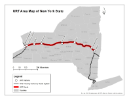Upstate Road Train

Batavia Station aerial view. Rendering: Letao Shen
The Upstate Road Train (URT) proposed for New York State is a state-of-the-art concept for intercity transportation. The overarching idea for this report was provided by Tim Tielman, executive director of the Campaign for Greater Buffalo History, Architecture & Culture. This report analyzes existing infrastructure to recommend how this URT system can be integrated into its fabric.
Gallery
Students
James Annunziata Junior, Shania Julia Anunciacion, Devin Barth, Viraja Bhosale, Ruth Bonnette, Lindsey Bruso, Yumeng Chen, Felicia Fortunado, Allison Gomez, Yunchao Han, Hannah Hanley, Marianna Holmes, Omar Ibrahim, Zachary Lee, Maya Miler, Tyson Morton, David Pulliam, Nick Sapone, Claudia Savoy, Letao Shen, Becky Szeto, David Tabak, Omar Tantawy, Devyn Walker, Huiyuan Zhang, Xing Xing Zheng.
Faculty
Jeffrey Rehler
Term
END 450
Fall 2020
Program
BAED
An optimal route for the URT would expand along the New York State Thruway, from Albany to Buffalo, stopping at many key upstate cities in between. It will be the first of its kind as it ranges the longest distance of any existing Bus Rapid Transit (BRT) system in the world. It is also planned to move at faster speeds than existing bus and train systems presently serving this corridor. This system will utilize the newest vehicle technology available to provide a comfortable and fast ride for travelers while also being environmentally sustainable. This system is designed to contain a total of eight stops and stations, with two in Buffalo, and one in Batavia, Rochester, Syracuse, Utica, Schenectady, and Albany. The optimal URT design would improve social, economic, and environmental conditions along the corridor, integrate with local transit, and re-energize historic downtowns. Equity, accessibility, and connectivity were key priorities in the design and planning of each station, which will serve as an easily accessible space for residents and travelers. Stations are also intentionally placed near other public transit hubs to provide connectivity to urban area.
Station locations prioritize connections to public transportation and limit the burden of transfers. Through research on demographic trends and best practices for bus rapid transit, the studio found that connecting riders directly into the city core increases accessibility greatly for those without private transportation. Proposed locations within downtown cores would not only increase transit access to underserved populations but help with revitalization efforts taking place in downtowns across New York State. These investments would benefit from transportation hubs and increased mobility options around historical and mostly auto-centric areas. Additional research guided recommendations regarding inclusivity, topography, ecology, existing infrastructure constraints, and safety considerations. The Upstate Road Train would be implemented through several phases over the course of the next several decades, concluding in 2050 in accordance with New York State’s goal to achieve zero emissions for all buses by that time. The first phase would be the addition of diesel buses onto the proposed median lane on the highway, with traffic signal priority for buses making local station stops. The final configuration of the Upstate Road Train will feature separated lanes for electric or hydrogen buses and designated lanes for local station connection.
Each of these recommendations and findings are supported by extensive research and collaboration with experts in public transportation and planning. This research and report findings are informative for the development of the proposed Upstate Road Train, and will hopefully lead to a new era of higher quality alternatives for public transit in upstate New York.
The Upstate Road Train presents an unprecedented opportunity to connect upstate cities in a sustainable and future-oriented manner. The URT rethinks interstate infrastructure to support public transportation, thereby increasing access and equity for intercity travel. The recommendations outlined in this report would connect upstate New York though eight stations through key cities and towns. The efficiency and environmentally conscious design of the fleet, route and stations aligns with New York State’s sustainability goals and the New York Department of Transportation’s sustainability mission. Beyond contributing to the sustainable transportation systems of the future, the Upstate Road Train elevates typical public transit experiences by offering smooth and spacious buses, direct connections to city centers and local transportation, and universally accessible facilities and vehicles. It is anticipated that investment into stations in downtown cores would help revitalize these historic areas and encourage more transit oriented development. Downtown station investment would encourage users both within and outside the city to use the URT. The system connects these cities in a very unique way. Commuters are able to travel a long distance without interruption from heavy traffic or refueling needs. As an efficient mode of public transit that brings people from city to city across upstate New York, the Upstate Road Train is designed for the future of long distance public transit.




